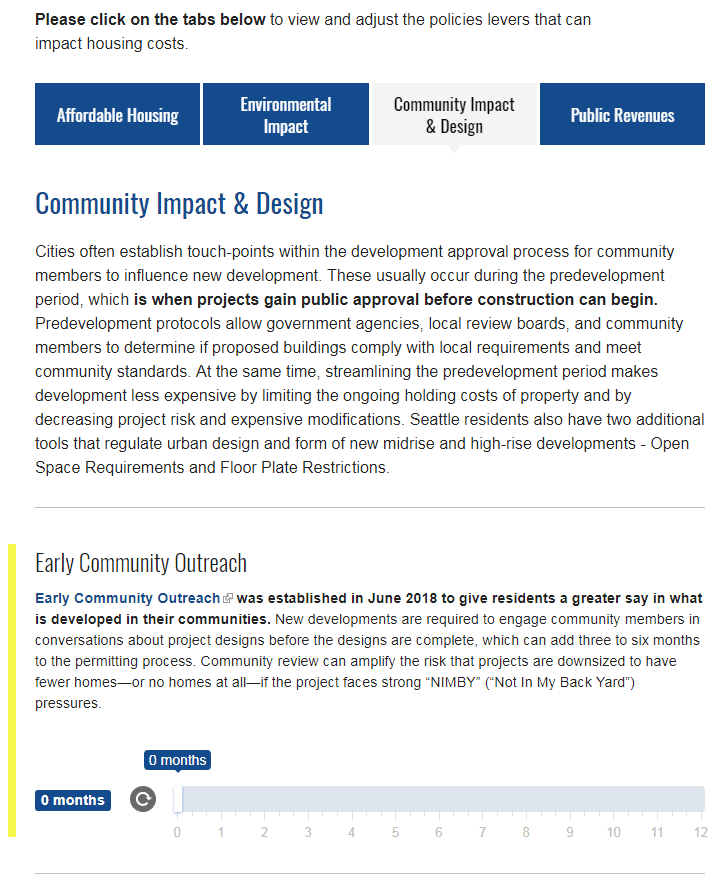Reading time: 9 minutes
The inputs for the calculator are based on changes in 13 policies unique to Seattle, grouped in four categories: Affordable Housing, Environmental Impact, Community Impact and Design, and Public Revenues. After adjusting these policy choices, users are provided a dollar amount for the change in rent for a one-bedroom apartment in either a midrise or high-rise apartment; the change in total units, development costs, and project feasibility for the building in questions; and the estimated changes in housing production, rent levels, cost burdening, and impact on the economy on a citywide scale.
“The purpose of the Housing Policy and Affordability Calculator is simple: to provide policymakers with an easy-to-use tool to fully understand the tradeoffs for specific policy choices,” said Mike Kingsella, Executive Director of Up for Growth National Coalition and one of the authors of the report. “Seattle is an ideal test case because the city has been forced to make difficult policy choices in the face of a growing housing shortage and increasing rents. We will be bringing the calculator to cities across the country.”
 Rather than advocate for or against a specific set of policies, the calculator is a model designed to explore tradeoffs inherent to policy changes and the resulting impact in overall affordability. However, the white paper associated with the calculator finds:
Rather than advocate for or against a specific set of policies, the calculator is a model designed to explore tradeoffs inherent to policy changes and the resulting impact in overall affordability. However, the white paper associated with the calculator finds:
- Pro-housing policies reduce overall rents significantly but stop short of providing affordable rents for lower-income households, suggesting a need for increased public resources and the local, state, and federal levels.
- Communities can generate significant affordability by leveraging tax policy and shortening the approval timeline.
- The predevelopment timeline can have significant and outsized effects on required rent and feasibility.
- Although each policy seems small in isolation, the cumulative impact of policies can be substantial.
The calculator was developed in partnership with HR&A and is the product of economic modeling, data analysis, and extensive surveys and interviews with affordable and market-rate builders and city officials to develop financial assumptions. Working with its members and partners in cities across the country, Up for Growth National Coalition intends to develop unique calculators in additional American cities. The calculator can be found on Up for Growth National Coalition’s website, along with a white paper that goes into detail about the economic model and assumptions included in the calculator.

What others are saying about the Housing Policy and Affordability Calculator:
“Up for Growth’s Housing Policy and Affordability Calculator will be an important tool to inform the conversation [on America’s housing affordability crisis], by quantifying the tradeoffs associated with local land use, building, zoning, and construction policies as measured by impacts on housing availability and affordability,” said U.S. Senator Todd Young (R-IN), who in 2018 introduced the bipartisan Task Force on the Impact of the Affordable Housing Crisis Act.
“This Housing Policy and Affordability Calculator serves two critical purposes for policy makers,” said Congressman Denny Heck (D-WA), who was one of the authors of the New Democrat Coalition’s “Missing Millions of Homes” report. “It makes stark that housing – not health care or education – is the biggest pressure in typical family budgets. And it lets us see how we can relieve this pressure through better policy that allows more construction. I look forward to seeing the Calculator used in policy discussions in Washington DC and state capitols around the country to enable us to start building the millions of homes we desperately need.”
“The Housing Policy and Affordability Calculator is an innovative tool that will drive better understanding of how public policy can either improve or undermine local housing affordability,” said Christopher Ptomey, Executive Director of the Terwilliger Center for Housing at Urban Land Institute. “Mayors and governors are increasingly focused on the nation’s housing challenges, and this tool will enable them and the residential development community to better understand, communicate, and advocate for reforms that will lower the cost of housing.”
“We must increase affordable housing options so that more people in our region can live near where they work,” said Marilyn Strickland, president and CEO of the Seattle Metropolitan Chamber of Commerce and a member of Up for Growth Action’s Washington State Steering Committee. “The Housing Policy and Affordability Calculator makes it easy to understand which policies add more housing and which ideas, like impact fees, are actually counterproductive.”
“The Housing Policy and Affordability Calculator helps policymakers and the public see that housing costs are not out of our control,” said Ethan Goodman, Executive Director of Seattle-based Tech 4 Housing and a member of Up for Growth National Coalition. “They’re driven by the policy tradeoffs that we collectively make. When we set policies that increase housing costs, it’s not just people in new buildings that bear that burden—cost increases mean fewer homes are built, exacerbating our housing shortage and pushing up costs for everyone.”
“While we all know that time is money, the calculator quantifies the impact of predevelopment time on rent levels,” said Cynthia Parker, President and CEO of nonprofit developer BRIDGE Housing and Board Chair of Up for Growth Action, an advocacy affiliate of Up for Growth National Coalition. “This is a powerful tool that can help communities produce the housing they need to serve all of their constituents.”
“When prosperous cities like ours fail to keep adding more homes of all shapes and sizes in all our neighborhoods, we build invisible walls that lock out those not privileged enough to own land,” said Michael Andersen, senior researcher for housing and transportation at Sightline Institute. “Up for Growth National Coalition’s new calculator is a powerful tool to help policymakers and citizens look honestly at the tradeoffs involved in dozens of housing policy decisions, so we can find the right balance to build fair, integrated, sustainable, and happy cities.”
“The members of the Housing Development Consortium have been developing affordable housing for over thirty years,” said Marty Kooistra and Leah Haberman of the Housing Development Consortium of Seattle-King County. “They know well the struggle in trying to scale their work to meet the need for 156,000 affordable homes in King County right now. The Up for Growth Housing Policy and Affordability Calculator is a helpful tool to illuminate the policy and regulation decisions that might have the unintended consequence of impeding our overall capability to produce housing at unprecedented scale.”
Up for Growth National Coalition is a coalition-driven 501(c)(3) non-profit organization, formed in 2018 to develop incisive research, educate, and elevate the conversation about the country’s housing affordability crisis. Up for Growth National Coalition represents a vibrant, diverse and growing coalition of stakeholders who believe that communities should grow for the benefit of every person. Our organization’s mission is to improve the quality of life for working families and individuals and create communities that are accessible and affordable for all by promoting more housing close to jobs, efficient and transportation, and in high opportunity neighborhoods.
For a copy of the press release, click here.
